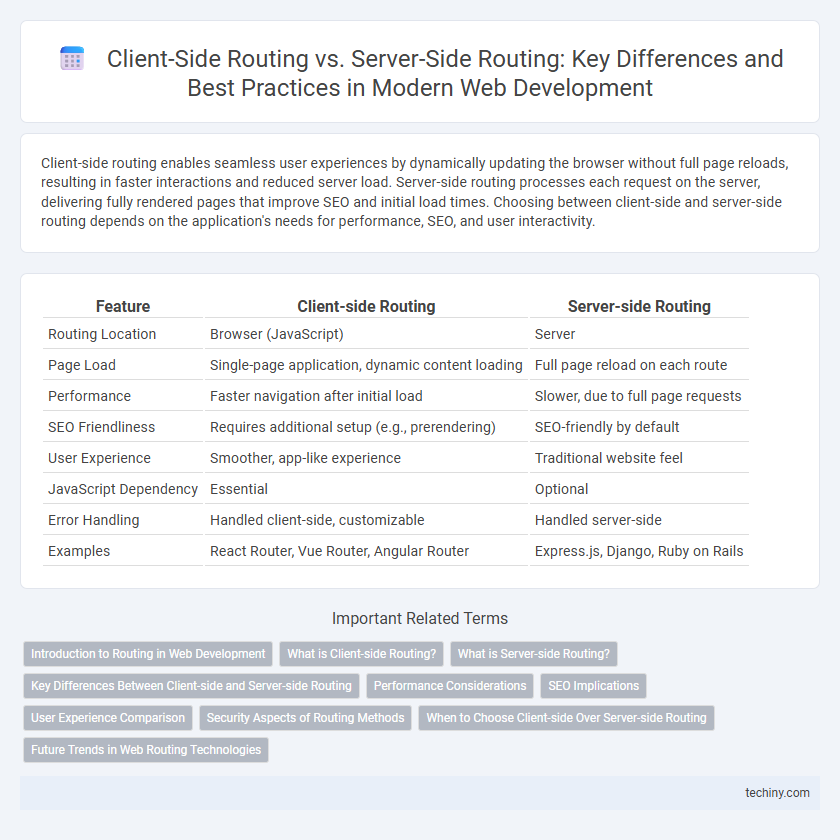Client-side routing enables seamless user experiences by dynamically updating the browser without full page reloads, resulting in faster interactions and reduced server load. Server-side routing processes each request on the server, delivering fully rendered pages that improve SEO and initial load times. Choosing between client-side and server-side routing depends on the application's needs for performance, SEO, and user interactivity.
Table of Comparison
| Feature | Client-side Routing | Server-side Routing |
|---|---|---|
| Routing Location | Browser (JavaScript) | Server |
| Page Load | Single-page application, dynamic content loading | Full page reload on each route |
| Performance | Faster navigation after initial load | Slower, due to full page requests |
| SEO Friendliness | Requires additional setup (e.g., prerendering) | SEO-friendly by default |
| User Experience | Smoother, app-like experience | Traditional website feel |
| JavaScript Dependency | Essential | Optional |
| Error Handling | Handled client-side, customizable | Handled server-side |
| Examples | React Router, Vue Router, Angular Router | Express.js, Django, Ruby on Rails |
Introduction to Routing in Web Development
Routing in web development directs user requests to specific resources or views, enabling seamless navigation within applications. Client-side routing leverages JavaScript frameworks like React and Angular to update the UI dynamically without full page reloads, enhancing performance and user experience. Server-side routing relies on backend servers such as Express.js or Django to handle URL requests and render complete HTML pages, ensuring robust content delivery and SEO benefits.
What is Client-side Routing?
Client-side routing manages navigation within a web application by dynamically updating the browser's URL and content without triggering a full page reload, enhancing performance and user experience. It leverages JavaScript frameworks like React, Angular, or Vue.js to intercept link clicks and render new views instantly on the client side. This approach reduces server load and enables faster, seamless transitions between pages by handling the routing logic entirely in the browser.
What is Server-side Routing?
Server-side routing is a web development process where the server handles URL requests and delivers corresponding HTML pages to the client. It involves the server interpreting the URL, fetching necessary data, and rendering the full page before sending it to the browser. This approach ensures better SEO, initial load performance, and compatibility with browsers that do not support JavaScript.
Key Differences Between Client-side and Server-side Routing
Client-side routing handles URL changes within the browser using JavaScript frameworks like React or Angular, allowing for faster navigation without full-page reloads by dynamically updating the view. Server-side routing relies on the server to respond to each URL request by rendering and delivering new HTML pages, ensuring better SEO and initial load performance but slower navigation speed. The primary differences include control location, with client-side routing managed in the browser and server-side routing handled on the server, impacting performance, SEO capabilities, and user experience.
Performance Considerations
Client-side routing enhances performance by reducing server load and enabling faster navigation through asynchronous content loading and DOM manipulation without full page reloads. Server-side routing may introduce latency due to repeated server requests and full page rendering but ensures better initial load speed and SEO benefits. Optimal performance depends on application complexity, with client-side routing suited for dynamic, single-page applications and server-side routing preferred for content-heavy, SEO-critical websites.
SEO Implications
Client-side routing often relies on JavaScript to dynamically load content, which can hinder SEO because search engines may struggle to index JavaScript-rendered pages effectively. Server-side routing delivers fully rendered HTML from the server, improving crawlability and ensuring better search engine visibility. Implementing server-side rendering (SSR) frameworks like Next.js or Nuxt.js offers a balance by enhancing user experience while maintaining SEO benefits.
User Experience Comparison
Client-side routing enhances user experience by enabling faster navigation through seamless page transitions without full page reloads, reducing latency and improving responsiveness. Server-side routing, while ensuring better initial load times and SEO, may cause slower interactions due to frequent server requests and page refreshes. Optimizing user experience involves balancing quick client-side updates with server-side rendering benefits for performance and accessibility.
Security Aspects of Routing Methods
Client-side routing reduces server load and improves performance by handling navigation within the browser, but it exposes more logic to users, increasing vulnerability to client-side attacks like Cross-Site Scripting (XSS). Server-side routing processes requests on the server, allowing stricter security controls, stronger access management, and better protection against data manipulation or injection attacks. Proper implementation combines secure server-side validation with safe client-side interaction to mitigate security risks in web applications.
When to Choose Client-side Over Server-side Routing
Client-side routing excels in single-page applications (SPAs) where seamless user experience and faster navigation without full page reloads are crucial, reducing server load by handling routing logic in the browser. It is ideal when dynamic content updates and interactive interfaces require immediate responsiveness, such as in social media platforms or complex dashboards. Choose client-side routing for applications demanding high user engagement, minimal latency, and efficient resource utilization at the client level.
Future Trends in Web Routing Technologies
Future trends in web routing technologies emphasize the integration of hybrid routing models combining client-side and server-side routing to optimize performance and user experience. Advanced frameworks leverage edge computing and serverless architectures to enable faster, scalable, and more dynamic content delivery. Innovations in Progressive Web Apps (PWA) and Single Page Applications (SPA) continue to shape routing strategies to reduce latency and improve SEO without sacrificing interactivity.
Client-side Routing vs Server-side Routing Infographic

 techiny.com
techiny.com